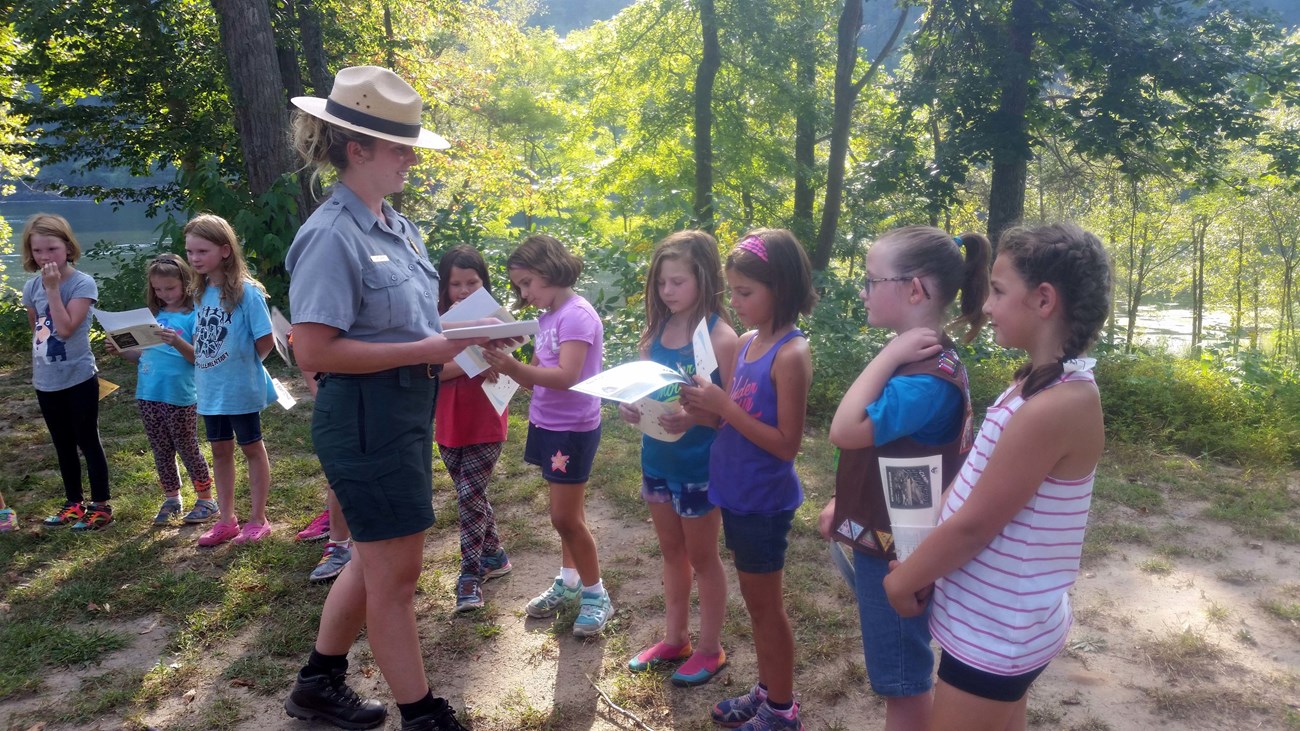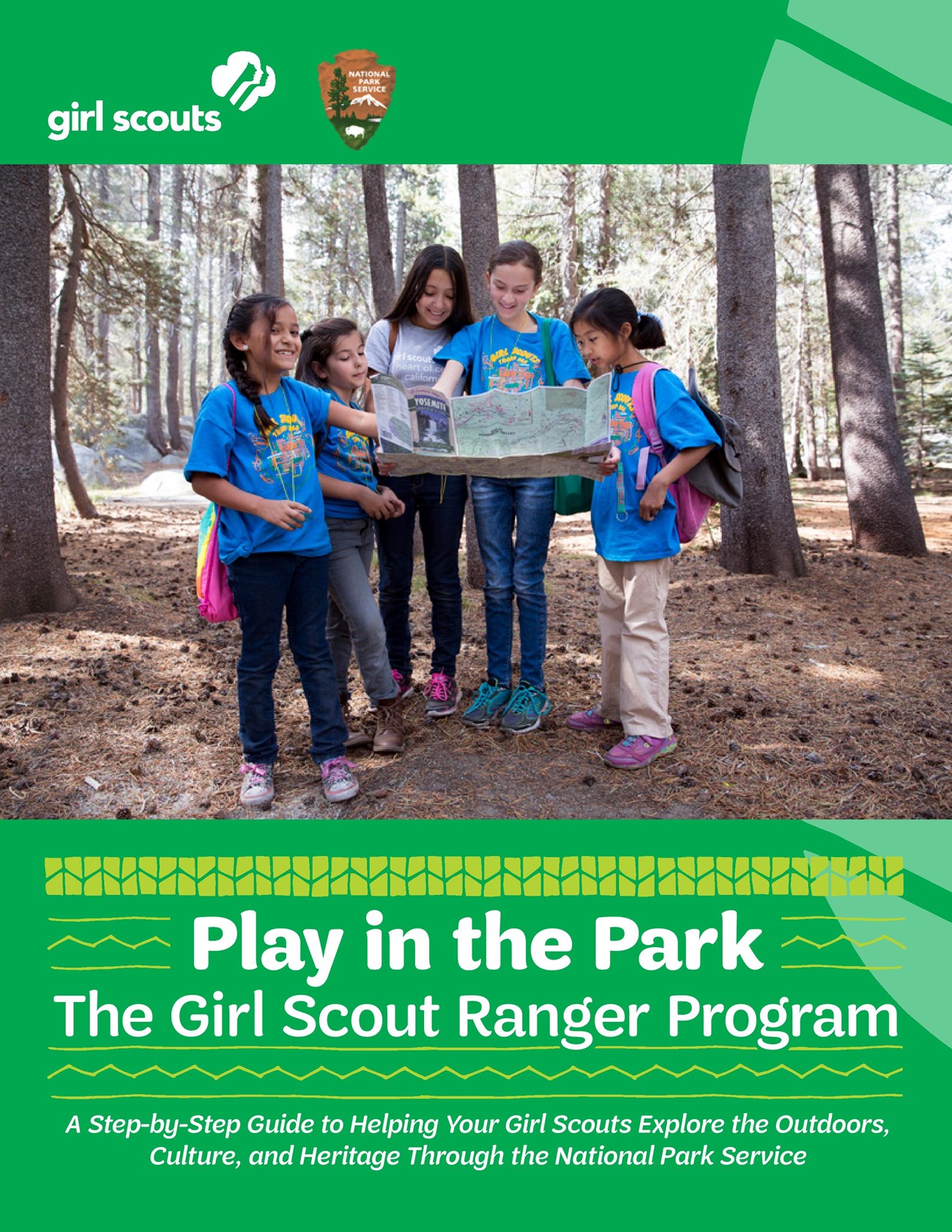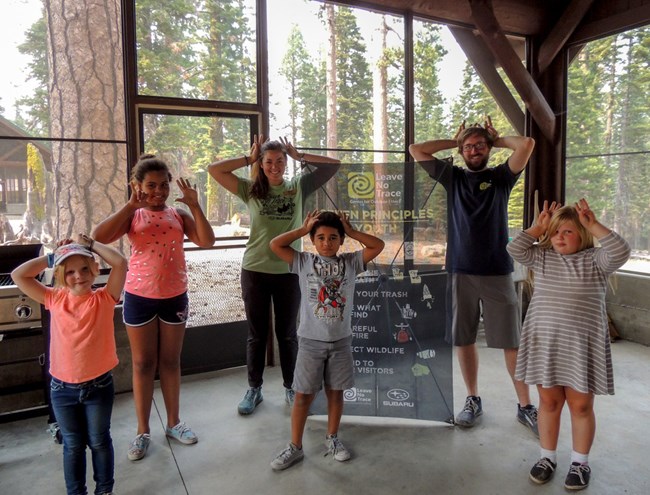
NPS Photo
Girl Scout Ranger Adult Leader Corner
The National Park Service and Girl Scouts of the USA have teamed up to cooperatively promote opportunities and activities to help Girl Scouts explore the outdoors!
Girl Scouts are invited to participate in a variety of existing educational or service projects at over 400 National Park Service sites, or design their own experiences to help them complete Girl Scout Journeys, badges, or a Take Action or Highest Award project. In addition to any badge or Journey requirements completed, NPS will also award Girl Scouts the Girl Scout Ranger certificate and/or patch for participation.

How to Get Started (this is a step-by-step guide of how to start the program with links to helpful resources embedded into the appropriate steps)
Visit the Find a Park webpage to find a park in your state or any park of interest.
- Have the girls use the NPS online map to search by their home state – or even surrounding states. If you have older girls who are ready for a travel adventure, they can search the entire U.S. for the park that sparks their interest! If you are not located near a national park, consider a visit to your own community’s parks, museums, and historic sites – you may be surprised how many are in your own backyard! If you can’t visit a national park right now, check to see if that park has a “Virtual Tour” for your girls to experience! Check for virtual tours on the park’s website under “Photos and Multimedia”.
-
Make a list of all the possible sites to visit, and then narrow it down to a few places to research.
Ask your girls to visit and explore the site’s website to learn about its history; the natural, cultural or historical resources it protects; and the activities that parks offers, such as hiking, biking, wildlife watching, and guided interpretive tours.
- To learn about activities the park offers, explore the website by looking at the Calendar or Things to Do sections. Girls will find helpful tips about activities, events, and practical things like directions, hours, reservations, and where to eat - and where to sleep, if you’re planning a trip!
-
To learn about what animals you might encounter at a park, check out the Girl Scouts Spotlight on Wildlife at U.S. National Parks Map! http://forgirls.girlscouts.org/spotlight-on-wildlife-map/
Once you have learned a little bit about the park, ask the girls to think about activities that interest them. Many of the parks describe the interpretive and educational programs they offer to the public and various volunteer opportunities on their website; think about how these programs can help enhance Girl Scouts Journeys or meet badge requirements. Record a list of ideas for possible activities and check out the Girl Scout Ranger Step-by-Step Guide for information on how to get your troop involved with the Girl Scout Ranger program.
- Many national parks offer field trips, guided tours, and other fun activities that require reservations. In some cases, there are self-guided tours available at flexible times! Tip: even if reservations for a program may not be mentioned on the park’s website, it’s always a good idea to call ahead, especially if you have a group of 10 or more.
- In addition to the activities you find on the park’s website, you may find service opportunities that are interesting to your girls - visit volunteer.gov to locate existing volunteer opportunities in national parks!
- Ask the girls to think about what badges or Journeys they are working on this year – or even want to earn next year? Are there things they can learn at the national park service site that can help them complete these badge or Journey awards? Here are some examples:
- Daisies:
- Ask a park ranger to teach Leave No Trace lessons on a nature walk based on colors or shapes.
- It’s Your Planet – Love It! - Between Earth and Sky Journey
- Brownies: Hiker badge
-
Juniors: Digital Photographer badge
-
Snap some city shots at a national historic site or monument or some seaside scenes at a national seashore.
-
-
- Cadettes: It’s Your Story – Tell it! MEdia Journey
- Create a publicity campaign or PSA about the Park
- Seniors: Adventurer badge
- Plan your own journey to two different national parks that girls choose!
- Ambassadors: It’s Your Planet - Love It – Justice Journey
- Interview a park ranger about environmental issues impacting the park. Think about a Take Action project that might help!
Contact the site to discuss the possible activities. Once on the park’s website, click on the Contact Us link in the left corner and email or call the park. Let them know that you are interested in participating in the Girl Scout Ranger Program and would like to contact the person who coordinates the program for the park.
- Be prepared to explain your ideas to the park representative: the number of Girl Scouts, their age range, skill level, and the project time commitment.
- Ask the park about to give you the inside scoop on existing opportunities you read about, or even additional things the girls didn’t find on the website. This could include volunteer service projects, career programs, special events and programs for youth, or nature conservation activities.
Work together with the NPS representative to plan the visit or project. The NPS representative can also suggest ideas for activities, and will work with you and the girls to ensure that the project is going to be fun, informative and help you gain a better understanding of the national parks and the many natural, cultural, and historical resources they protect!
- Service vs. Take Action: What’s the Difference?
-
There may be opportunities to participate in existing service projects at parks, or possibly even for the girls to create a Take Action project! Girl Scouts do both community service and Take Action. Both kinds of projects are important and help communities in different ways. What’s the difference?
-
Direct and immediate service changes something right now. Longer-lasting action gets at the root cause of issues.
-
Service makes the world better for some people “right now.” For example, cleaning up hiking trails helps people enjoy parks “right now.” Picking up trash helps animals and people enjoy their environment “right now.” Providing clothing and toiletries to people who have suffered a disaster helps them get through a difficult event “right now.” These acts of kindness are important ways to help some people—right now.
- Take Action projects, along with the Girl Scout Bronze, Silver, and Gold Awards, address the root cause of an issue, and come up with sustainable, longer-lasting solutions. These projects strive to make the world a better place for more people for a much longer time. For example, a Girl Scout Brownie troop may help plan and create an accessible trail at a national park, or a Girl Scout Senior may develop a curriculum for ongoing educational programs to teach younger children about the history of a national monument.
-
-
- Sometimes, service and action just naturally blend together into one sustainable effort. Girl Scouts use both service and Take Action to live out the Girl Scout Law and “make the world a better place!”
- Think about some key dates throughout the year!
-
FEBRUARY
-
World Thinking Day, February 22, celebrates the birthdays of Girl Guides/Girl Scouts founder Robert, Lord Baden-Powell (1857–1941) and World Chief Guide Olave, Lady Baden-Powell (1889–1977).
-
-
MARCH
-
Girl Scouts’ Birthday, March 12, commemorates the day in 1912 when Juliette Gordon Low officially registered the organization's first 18 girl members in Savannah, Georgia.
-
-
APRIL
-
National Park Week
-
Earth Day, April 22
-
Girl Scout Leader's Day, April 22, honors all the volunteers who work as leaders and mentors in partnership with girls. On this day, girls, their families, and communities find special ways to thank their adult Girl Scout volunteers.
-
-
JUNE
-
Get Outdoors Month
-
National Trails Day
-
-
AUGUST
-
National Park Service Birthday
-
-
SEPTEMBER
-
National Public Lands Day
-
-
Once all the logistics are set up, go and have fun with the Girl Scout Ranger Program!
- Safety First: Troop leaders: be sure to familiarize yourself with your council’s Safety Activity Checkpoints for each activity you’ll be doing, and ask the local national park service site what guidelines they have in place to keep visitors safe!
- Leave No Trace: Visiting a national park is a great opportunity to teach your girls how to enjoy the outdoors responsibly. Teach your girls the seven principles of Leave No Trace!
- Know Before You Go
- Choose The Right Path
- Trash Your Trash
- Leave What You Find
- Be Careful With Fire
- Respect Wildlife
- Be Kind to Other Visitors
Tell NPS and GSUSA what you did!
- Encourage girls to share their experience at NPS sites by sending an e-mail and photograph to e-mail us.
- Posting photos of your experience in parks on the Girl Scouts’ national website by using #gsoutdoors in your Facebook Twitter photo posts!
- Girls should also submit any Take Action projects completed at NPS sites to GSUSA’s Map It! Girls Changing the World online map.
- Volunteer Recognition:
-
George and Helen Hartzog Awards for Outstanding Volunteer Service – The George and Helen Hartzog Award recognizes individual and group achievement for outstanding volunteer service in national parks. Next time your troop or individual Girl Scout volunteers at a national park, be sure to inquire about the award and nomination process!
- Take Pride in America is a national partnership program that encourages, supports, and recognizes volunteers who work to improve public parks, forests, grasslands, reservoirs, wildlife refuges, cultural and historical sites, local playgrounds, and other recreation areas. There are national awards each year. For more information, please visit www.takepride.gov
-
You may want to bring back the knowledge you gain at NPS sites to develop Take Action Projects in your community. This is a great option, especially if you are visiting a smaller NPS site that does not have a need for your project, or a site that is too far away from your hometown for multiple return visits. here. (Link to Girl Scout Journeys & the NPS sheet) Or, see what kind of Take Action project Girl Scouts are doing all over the country.

NPS Photo
What is Leave No Trace?
Leave No Trace is an outdoor ethics program that teaches people of all ages how to enjoy the outdoors responsibly. Learn more about Leave No Trace and how you can practice the seven principles during your park visit.
Volunteer Opportunities
Did you know that youth account for more than 40% of National Park Service volunteers? Volunteers of any age who serve more than 250 hours in one year are eligible for a FREE annual public lands pass – click on the image below or go to volunteer.gov for more information.
Last updated: February 17, 2022

